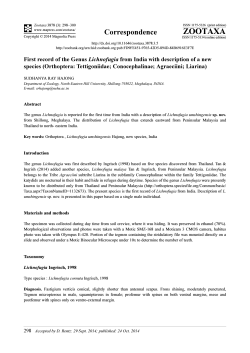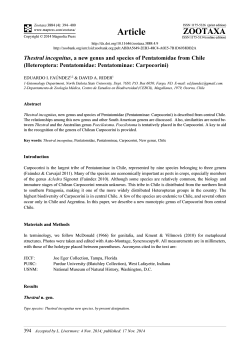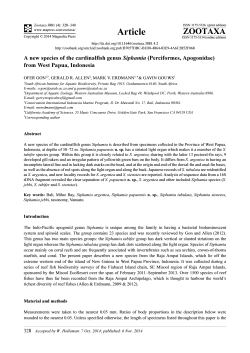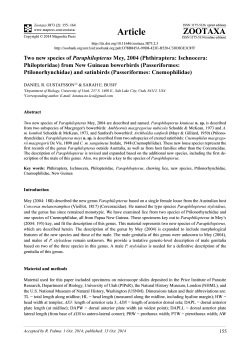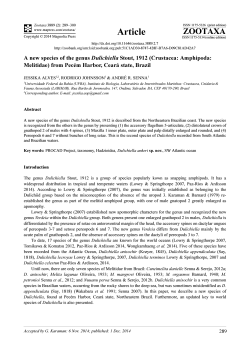
A new species of the rare nematode genus
Zootaxa 3904 (4): 563–571 www.mapress.com /zootaxa / Copyright © 2015 Magnolia Press Article ISSN 1175-5326 (print edition) ZOOTAXA ISSN 1175-5334 (online edition) http://dx.doi.org/10.11646/zootaxa.3904.4.5 http://zoobank.org/urn:lsid:zoobank.org:pub:3999945E-A42C-4963-A479-CA56B27C3950 A new species of the rare nematode genus Paramicrolaimus Wieser, 1954 (Chromadorida: Paramicrolaimidae) from the south eastern Arabian Sea JINI JACOB, ABDUL JALEEL K. U. & ANIL KUMAR VIJAYAN Centre for Marine Living Resources & Ecology, Ministry of Earth Sciences, Block-C, 6th Floor, Kendriya Bhavan, Kakkanad, Kochi – 682037, Kerala, INDIA Abstract A new paramicrolaimid nematode, Paramicrolaimus damodarani sp. nov., is described based on specimens from the continental shelf (95 m) of the south eastern Arabian Sea. Paramicrolaimus damodarani sp. nov. differs from other known species of the genus in having a smaller body size, form of the spicular apparatus, presence of 7 cuticularised protruding precloacal supplements and a strongly cuticularised terminal spinneret. This is the first record of the genus Paramicrolaimus from the northern Indian Ocean. A pictorial key to the four species of Paramicrolaimus is also provided, supplemented with comparative characters, based on published information. Key words: Nematode, Arabian Sea, Indian Ocean, Paramicrolaimus, morphology, taxonomy, Identification key Introduction The genus Paramicrolaimus Wieser, 1954 is the type and sole genus in Paramicrolaimidae, a rare family of free living nematodes whose species are known from a few individual specimens (Holovachov 2014). There are few reports on the species of Paramicrolaimus, despite the volume of work carried out on diversity and systematics of marine free living nematodes across the world’s oceans. Given its general body shape, circular amphid, rounded blunt head with crowns of cephalic setae, the typical shape and teeth of the sclerotised buccal cavity and the preanal papillae, the genus was originally placed under family Microlaimidae by Wieser, 1954. However, it differed from the other genera of Microlaimidae in having the two circles (6+4) of cephalic setae of more or less equal size, transversely oval shaped amphids with a small dorsal limb, oesophageal bulb almost absent or weakly developed and females with two antidromously reflexed ovaries. While revising the Microlaimidae, Jensen (1978) discussed the obscurity of the systematic position of Paramicrolaimus. The slender and similar setae of the second and third crowns of cephalic sense organs, reduced buccal cavity and male gonads with one anteriorly directed outstretched testis suggest affinity of this genus with the Stilbonematinae (Spiriniidae); prompting Jensen (1978) to assign the genus to this family. Jensen (1978) also mentioned that Paramicrolaimus resembles the genus Coninckia in the arrangement of the cephalic sense organs, the shape of the male amphids, the structure of the oesophagus and the shape of the tail, but regarded these features as additional characters for distinguishing species. Lorenzen (1981) in classifying free living nematode species, contributed significant new interpretations and clarified the ambiguities in the systematics of Paramicrolaimus by erecting a new family Paramicrolaimidae. Since this revision, only one species, Paramicrolaimus mirus Tchesunov, 1988 has been described. In all, only 3 species of Paramicrolaimus are currently known. A new species of Paramicrolaimus is described here, based on specimens collected off the southwest coast of India, in the south eastern Arabian Sea. This is the first record of Paramicrolaimus in the northern Indian Ocean. Accepted by K. Davies: 21 Nov. 2014; published: 8 Jan. 2015 563 TABLE 2. Morphometry of valid Paramicrolaimus species. Species P. primus Wieser, 1954* P. spirulifer Weiser, 1959 P. spirulifer Weiser, 1959 P. mirus Tchesunov, 1988 P. mirus Tchesunov, 1988 Source Original description Original description Redescription Jensen, 1978 Original description Redescription Huang and Zhang, 2005 L (µm) 2340 4180–4430 5170 3500–4060 3052–3600 1225–1310 mbd (µm) 52.3 30 38 33.3–38.3 38–40.2 24–25 a 44.7 139.3–147.7 136 105–106 76.3–89.5 51–52.4 b 16.8 22.1–29.3 23.5 21.7–21.8 15.9–19.8 8.8–9.14 c 22.3 52.2–55.4 30.6 28–40.5 30.5–36.7 18.8–20.32 Anterior cs (µm) 9 9–12 16 6 7–8 13 Posterior cs (µm) 10 10–16 18 8 9–10 14–15 aw (µm) 12 13–14 16 12 11–13 11–12 Oesophagus length (µm) 139.3 142.7–200.5 220 160.6–187.1 172–192 140–145 S (µm) – 25 39 23 45–50 28–29 No. of supplements – 6 10 9 10 7 t (µm) 104.9 80 169 100.2–125 98–105 63–65 P. damodarani sp. nov. * measurements of female. Acknowledgement This work was carried out under the Marine Living Resources Programme of the Ministry of Earth Sciences, Govt. of India. The support and encouragement of Dr. V. N. Sanjeevan (Former Director, CMLRE), Dr. R. Damodaran, Dr. Rosamma Philip (CUSAT), Dr. A. Shivaji, Dr. G. V. M. Gupta (CMLRE) are gratefully acknowledged. The authors wish to thank Ms. Usha V. Parameswaran, Ms. Aiswarya Gopal and Mr. Kevin P. V. for constant support and motivation in the laboratory. The authors acknowledge the efforts of Ms. Shruthi Venugopal and support staff on FORV Sagar Sampada (FORVSS 295) during sampling. The authors also wish to thank Dr. Alexei V. Tchesunov (Lomonosov Moscow State University, Russia) and Dr. Oleksandr Holovachov (Swedish Museum of Natural History, Sweden) for the references they have sent. References Filipjev, I. (1929) Les Nematodes libres de la baie de la Neva et de I’extremite orientale du Golfe de Finlande. Premiere partie. Archiv fur Hydrobiologie, 20, 637–699. Holovachov, O. (2014) 7.16 Order Plectida Gadea, 1973. In: Schmidt-Rhaesa, A. (Ed.), Handbook of Zoology. Gastrotricha, Cycloneuralia, Gnathifera. Vol. 2. Nematoda. de Gruyter, Berlin, pp. 487–535. Huang, Y. & Zhang, Z. (2005) Two new species and one new record of free-living marine nematodes from the Yellow Sea, China. Cahiers de Biologie Marine, 46, 365–378. Jensen, P. (1978) Revision of Microlaimidae, erection of Molgolaimidae fam .n. and remarks on the systematic position of Paramicrolaimus (Nematoda, Desmoddorida). Zoologica Scripta, 7, 159–173. http://dx.doi.org/10.1111/j.1463-6409.1978.tb00599.x Lorenzen, S. (1981) Entwurf eines phylogenetischen Systems der freilebenden Nematoden. Veröffentlichen. Institut fur Meeresforschung Bremerhaven, 7 (Supplement), 1–449. Platt, H.M. & Warwick, R.M. (1988) Free-living Marine Nematodes. Part II. British Chromadorids. In: Kermack, D.M. & Barnes, R.S.K. (Eds.), Synopses of the British Fauna, New Series, No. 38, pp. 1–502. [Brill, Leiden] Seinhorst, J.W. (1959) A rapid method for the transfer of nematodes from fixative to anhydrous glycerin. Nematologica, 4, 67–69. http://dx.doi.org/10.1163/187529259x00381 570 · Zootaxa 3904 (4) © 2015 Magnolia Press JACOB ET AL. Tchesunov, A.V. (1988) New species nematodes from the White Sea. Proceedings of the Zoological Institute, 180, 68–76. [Leningrad] Vanaverbeke, J., Bezerra, T.N., Braeckman, U., De Groote, A., De Meester, N., Deprez, T., Derycke, S., Guilini, K., Hauquier, F., Lins, L., Maria, T., Moens, T., Pape, E., Smol, N., Taheri, M., Van Campenhout, J., Vanreusel, A., Wu, X. & Vincx, M. (2014) NeMys: World Database of Free-Living Marine Nematodes. Available from: http://nemys.ugent.be (accessed 11 November 2014) Wieser, W. (1954) Free-living marine nematodes. Chromadoroidea. Acta Universita Lundensis, 50, 1–48. Wieser, W. (1959) Free-living marine nematodes and other small invertebrates of Puget Sound Beaches. University of Washington Press, Seattle, 179 pp. PARAMICROLAIMUS FROM THE INDIAN OCEAN Zootaxa 3904 (4) © 2015 Magnolia Press · 571
© Copyright 2025


